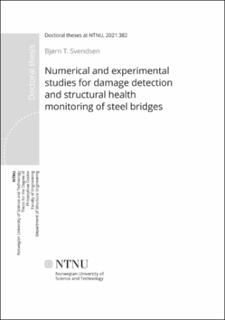| dc.contributor.advisor | Rønnquist, Anders | |
| dc.contributor.advisor | Øiseth, Ole Andre | |
| dc.contributor.author | Svendsen, Bjørn T. | |
| dc.date.accessioned | 2022-02-11T07:54:36Z | |
| dc.date.available | 2022-02-11T07:54:36Z | |
| dc.date.issued | 2021 | |
| dc.identifier.isbn | 978-82-326-5895-4 | |
| dc.identifier.issn | 2703-8084 | |
| dc.identifier.uri | https://hdl.handle.net/11250/2978371 | |
| dc.description.abstract | There is a vast number of existing bridges in infrastructure that are approaching or have exceeded their original design lives. A large part of these bridges are steel and composite steel-concrete bridges. The primary damage mechanism in these bridges is fatigue, which can lead to component failure that is critical for the structural integrity. Structural health monitoring systems can provide information regarding the state of the bridge condition, with the aim of increasing the economic and life-safety benefits through damage detection. The primary motive of structural health monitoring is to design a system that minimizes false positive indications of damage for economic and reliability concerns and false negative indications of damage for life-safety issues. For infrastructure owners, structural health monitoring systems can result in enhanced decision support and structural diagnosis of the structure.
This thesis considers damage detection and structural health monitoring through numerical and experimental studies of a full-scale steel bridge. An essential part of this research is the establishment of an experimental benchmark study to obtain response measurement data under different structural state conditions with imposed damage. The thesis consists of four papers, referred to as parts. In the first part, the damage detection possibilities for improved bridge inspection are determined. Damage detection of existing structural damage is assessed through analysis of response measurements obtained from a systematic experimental study using a modal hammer. In the second part, a strategy to effectively establish a validated numerical finite element model using model updating is developed and implemented. A validated finite element model can be utilized to perform numerical simulations for damage detection and structural health monitoring purposes.
The research then follows logically into using the validated finite element model in the third part. More specifically, a novel hybrid structural health monitoring framework for damage detection is proposed by integrating numerical models, experimental data, and machine learning. A challenge in structural health monitoring is that almost all statistical decision making must be done in an unsupervised learning mode. This part aims at providing an important contribution towards solving this challenge. Finally, a data-based structural health monitoring approach for damage detection in bridges using only experimental data is presented in the fourth paper. Damage detection of local and global structural damage using an unsupervised learning algorithm by novelty detection is performed. Furthermore, the detectability of different damage types within the established dataset is evaluated by considering the average performance of four supervised learning algorithms.
In this thesis, current approaches for damage detection and structural health monitoring of bridges have been implemented, evaluated, and further developed through numerical and experimental studies. The results presented demonstrate that damage detection of bridges can be performed using structural health monitoring approaches and practices. In conclusion, this thesis provides valuable contributions to the field of structural health monitoring regarding its application to bridges. | en_US |
| dc.language.iso | eng | en_US |
| dc.publisher | NTNU | en_US |
| dc.relation.ispartofseries | Doctoral theses at NTNU;2021:382 | |
| dc.relation.haspart | Paper 1:
Svendsen, Bjørn Thomas; Frøseth, Gunnstein Thomas; Rønnquist, Anders.
Damage Detection Applied to a Full-Scale Steel Bridge Using Temporal Momens. Shock and Vibration;Volum 2020. Article ID 3083752
https://doi.org/10.1155/2020/3083752
This is an open access article distributed under the Creative Commons Attribution License, (CC BY 4.0) | |
| dc.relation.haspart | Paper 2:
Svendsen, Bjørn Thomas; Petersen, Øyvind Wiig; Frøseth, Gunnstein Thomas; Rønnquist, Anders.
Improved finite element model updating of a full-scale steel bridge using sensitivity analysis. Structure and Infrastructure Engineering 2021
https://doi.org/10.1080/15732479.2021.1944227
This is an Open Access article distributed under the terms of the Creative Commons Attribution-NonCommercial-NoDerivatives License (CC BY-NC-ND 4.0) | |
| dc.relation.haspart | Paper 3:
Svendsen, B. T., Øiseth, O., Frøseth, G. T., and Rønnquist, A. (2021). A hybrid
structural health monitoring approach for damage detection in steel bridges under
simulated environmental conditions using numerical and experimental data.
- The final published version is available in Structural Health Monitoring. May 2022.
https://doi.org/10.1177/14759217221098998
This article is distributed under the terms of the Creative Commons Attribution 4.0 License (CC BY 4.0) | |
| dc.relation.haspart | Paper 4:
Svendsen, Bjørn Thomas; Frøseth, Gunnstein Thomas; Øiseth, Ole Andre; Rønnquist, Anders.
A data-based structural health monitoring approach for damage detection in steel bridges using experimental data. Journal of Civil Structural Health Monitoring (JCSHM) 2021 ;Volum 12. s. 101-115
https://doi.org/10.1007/s13349-021-00530-8.
This article is licensed under a Creative Commons Attribution 4.0 International License (CC BY 4.0) | |
| dc.title | Numerical and experimental studies for damage detection and structural health monitoring of steel bridges | en_US |
| dc.type | Doctoral thesis | en_US |
| dc.subject.nsi | VDP::Technology: 500::Building technology: 530::Construction technology: 533 | en_US |
